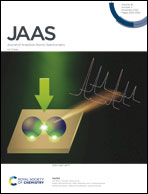Rapid classification of soils from different mining areas by laser-induced breakdown spectroscopy (LIBS) coupled with a PCA-based convolutional neural network
Abstract
The pollution of the surrounding soil can be caused by the development of heavy metal mining areas, which can do a significant harm to the ecological environment and human health. The classification of soil in different mining areas is of great significance for soil management and environmental pollution control. Due to the complex physical property and composition of soil, it is easily affected by matrix effects, which can directly affect the collection and processing of spectral data. It is thus challenging to accurately classify soil. In this article, laser-induced breakdown spectroscopy (LIBS) combined with a convolutional neural network with a two-dimensional (2D-CNN) algorithm, which was based on principal component analysis (PCA), was used to accurately identify and classify standard soil samples from ten different mining areas. The sample data were first standardized and dimensionlessly pre-processed by PCA to remove redundant information and to improve the signal-to-noise ratio (SNR) of the data. Then, the structure of 2D-CNN was designed, and the features of the input data were deeply extracted twice by convolution and pooling operations, so that more feature information could be extracted from the data, which was conducive to improving the classification accuracy of the model. The experiment results show that the classification accuracy of the 2D-CNN test set could reach 99.60% and the loss could be minimized at 0.012. In order to verify the superior performance of the 2D-CNN-based PCA classification model, the 2D-CNN algorithm was compared with other models, including back propagation artificial neural network (BP-ANN), support vector machine (SVM), k-nearest neighbor (KNN), and random forest (RF). The results show that 2D-CNN has great potential in the field of soil recognition and classification, and provides a new and reliable data processing method for LIBS to classify materials with similar chemical properties.



 Please wait while we load your content...
Please wait while we load your content...